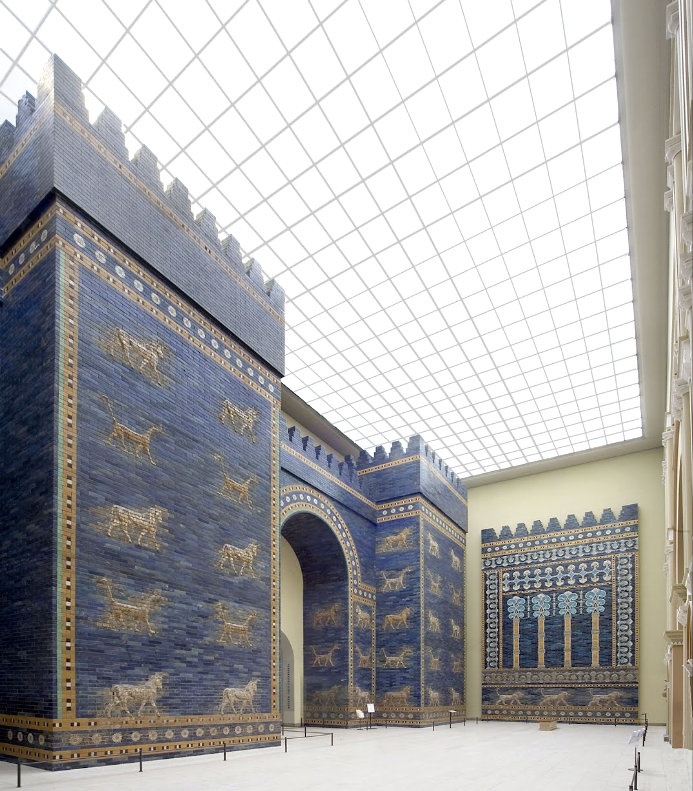The Pergamon Museum (German: Pergamonmuseum) is situated on the Museum Island in Berlin. The building was designed by Alfred Messel and Ludwig Hoffmann and was constructed over a period of twenty years, from 1910 to 1930. The Pergamon Museum houses monumental buildings such as the Pergamon Altar, the Ishtar Gate of Babylon, and the Market Gate of Miletus reconstructed from the ruins found in ancient Middle East and Turkey.
The museum is subdivided into the antiquity collection, the Middle East museum, and the museum of Islamic art. It is visited by approximately 1,135,000 people every year, making it the most visited art museum in Germany (2007), and is one of the largest in the country.
The Pergamonmuseum was designed by Alfred Messel; its construction was overseen by Ludwig Hoffmann and lasted twenty years, from 1910 to 1930. A smaller building initially stood on the same site for a just few years before being torn down. It housed the important excavation finds unearthed by the Berlin museums, such as the frieze panels from the Pergamon Altar, reclaimed from the earth in digs that lasted from 1878 to 1886. Inadequate foundations, however, soon resulted in the building becoming structurally unstable and it had to be demolished. The new, larger Pergamonmuseum was built as a three-wing complex. The museum now houses three of the Staatliche Museen zu Berlin’s collections: the Antikensammlung, Vorderasiatisches Museum, and the Museum für Islamische Kunst. The impressive reconstructions of massive archaeological structures – the Pergamon Altar, Market Gate of Miletus, the Ishtar Gate and Processional Way from Babylon, and the Mshatta Facade – have made the Pergamonmuseum famous throughout the world, with the result that it is the most visited museum at the Staatliche Museen and in Germany as a whole. Since 2013, the Pergamonmuseum has been undergoing staggered renovation work, devised by the Ungers architectural practice, as part of the Master Plan Museumsinsel. During the current stage of renovations, the hall containing the Pergamon Altar is closed since 29 September 2014 and is due to remain closed to the public until 2019. The north wing and the gallery of Hellenistic art are also affected by the closure. The South Wing of the Pergamonmuseum, featuring the Market Gate of Miletus, the Ishtar Gate and Processional Way from Babylon, and the Museum of Islamic Art, remains unaffected and will be open to the public during this time.
Antiquity Collection (Antikensammlung):
The collection goes back to the prince-electors, or Kurfürsten, of Brandenburg, who collected objects from antiquity; the collection began with an acquisition to the collection by a Roman archaeologist in 1698. It first became accessible (in part) to the public in 1830, when the Altes Museum was opened. The collection expanded greatly with the excavations in Olympia, Samos, Pergamon, Miletus, Priene, Magnesia, Cyprus and Didyma.
The collection contains sculpture from the archaic to Hellenistic ages as well as artwork from Greek and Roman antiquity: architecture, sculptures, inscriptions, mosaics, bronzes, jewelry and pottery.
The main exhibits are the Pergamon Altar from the 2nd century BC, with a 113 meters (371 ft) long sculptural frieze depicting the struggle of the gods and the giants, and the Gate of Miletus from Roman antiquity.
Islamic Art Museum (Museum für Islamische Kunst):
Further information: Islamic art
When the Bode Museum was opened in 1904, a section for Islamic art was created and later included in the Pergamon Museum (1950).
Besides Islamic artwork from the 8th to the 19th century ranging from Spain to India, the main attraction is the Mshatta facade, which originates from an unfinished early Islamic desert palace located south of Amman in present-day Jordan. It was a gift from the Ottoman Sultan Abdul Hamid II to Emperor Wilhelm II of Germany. Parts of the eastern portion of the facade and the ruins of the structure of which it formed a part remain in Jordan.
Another unique exhibition is the Aleppo room. This area of the museum features a reception room from a broker’s home in Aleppo, Syria, that was commissioned during the Ottoman Period.
The Islamic Art Museum also regularly hosts temporary exhibitions of modern art from the Islamic world, such as the 2008 Turkish Delight (contemporary Turkish design) and Naqsh (Gender in Iranian Art and Society).
The Middle East Museum (Vorderasiatisches Museum):
The Middle East Museum exhibition displays objects found by German archeologists and others from the areas of Assyrian, Sumerian and Babylonian culture. Additionally there are historical buildings, reliefs and lesser cultural objects and jewelry.
The main display is the Ishtar Gate and the Processional Way of Babylon together with the throne room facade of Nebuchadnezzar II. The Vorderasiatisches Museum also displays the Meissner fragment from the Epic of Gilgamesh.
